MOG Report: An In-depth Analysis of Global Organizational Culture
VerifiedAdded on 2020/03/04
|11
|1968
|40
Report
AI Summary
This report, titled "MOG Report: Organizational Culture," delves into various facets of organizational culture within a global context. It begins by examining corporate culture and strategy, exploring different cultural practices like market, clan, adhocracy, and hierarchy, and evaluating their effectiveness. The report then provides an overview of cultural organizations, followed by a case study on Zappos, analyzing the impact of its work culture on HRM practices and customer satisfaction. A significant portion is dedicated to Toyota's corporate culture, outlining its seven dimensions and the challenges of spreading its culture. The report concludes with an examination of the cultural web model and its practical application. Through these activities, the report offers an evaluative perspective on organizational culture, providing valuable insights into its complexities and impact.
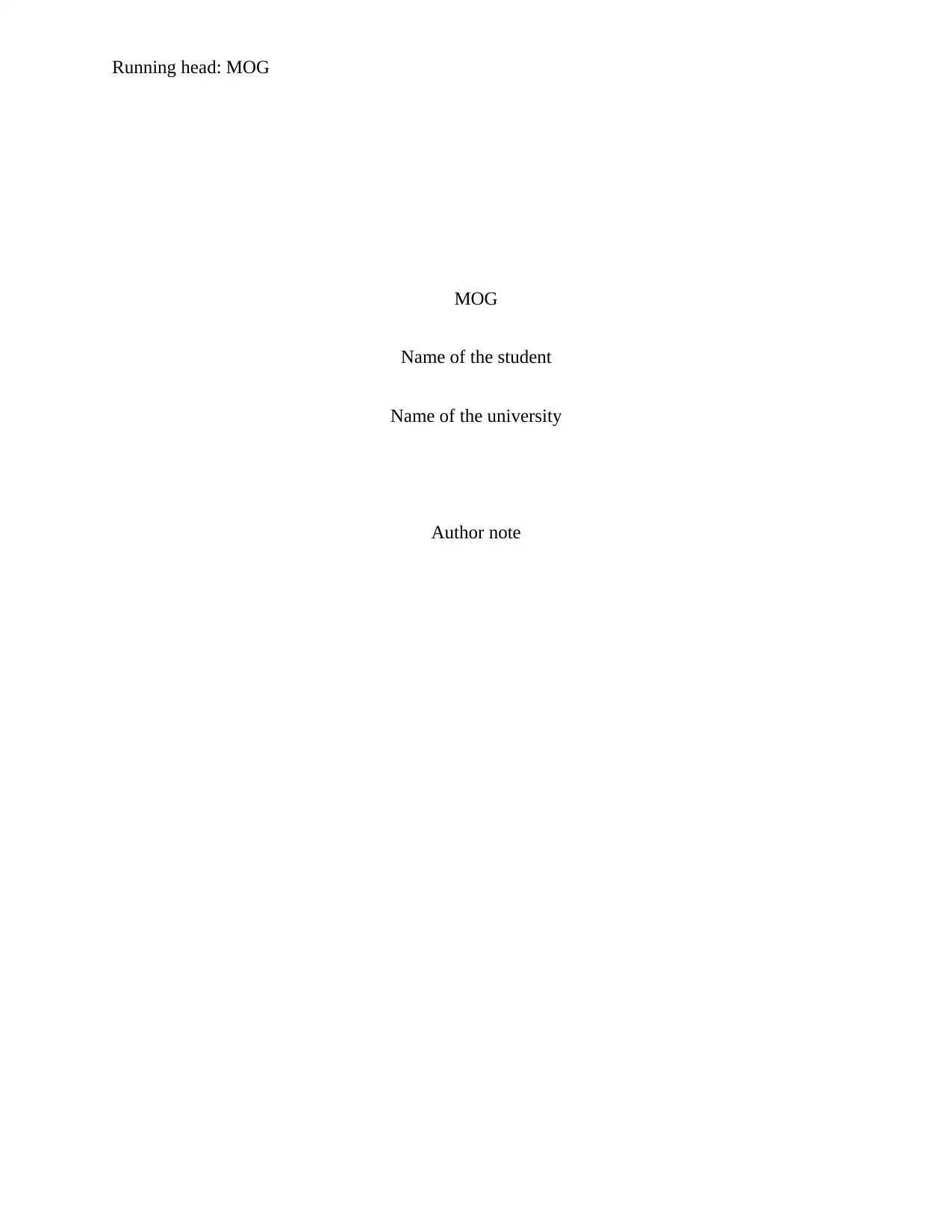
Running head: MOG
MOG
Name of the student
Name of the university
Author note
MOG
Name of the student
Name of the university
Author note
Paraphrase This Document
Need a fresh take? Get an instant paraphrase of this document with our AI Paraphraser
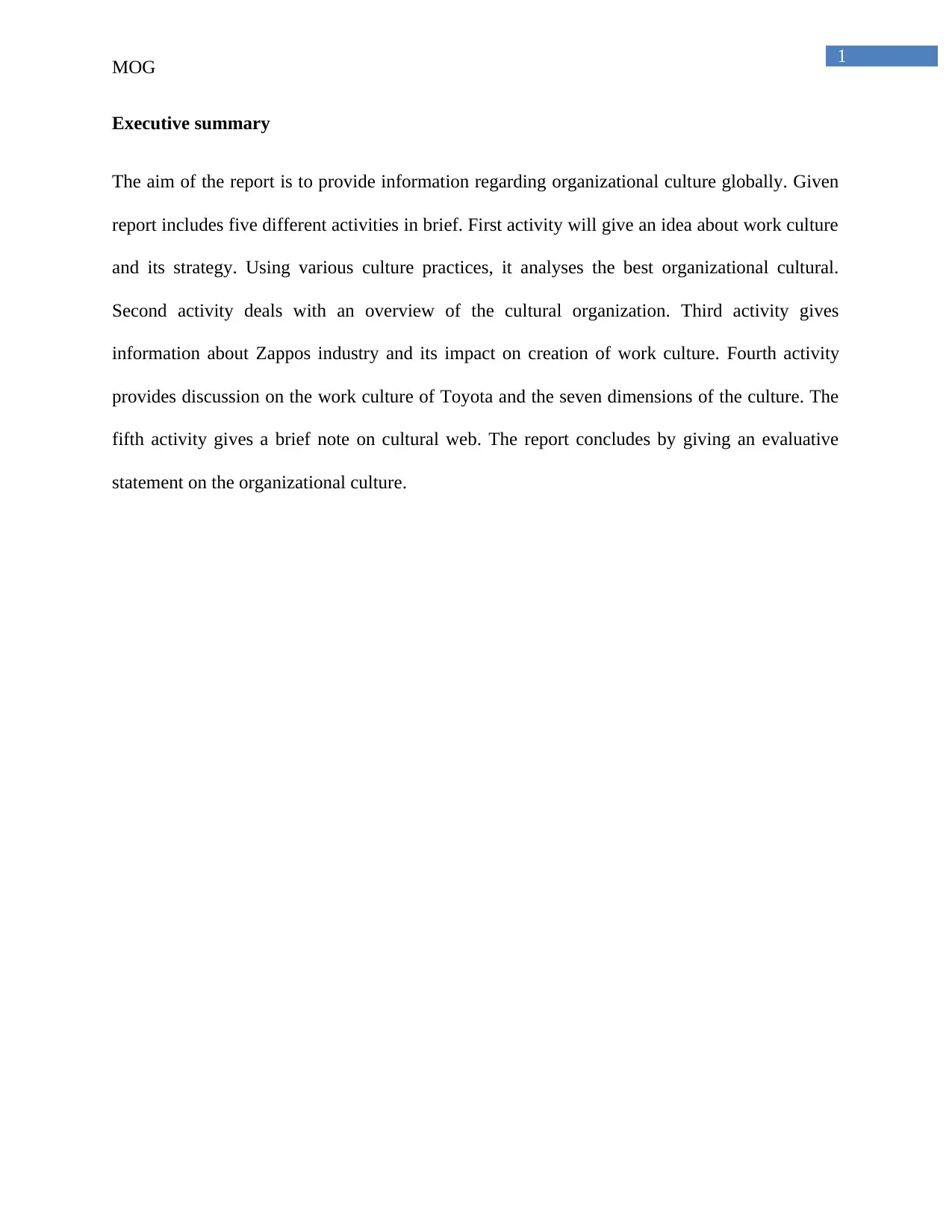
1
MOG
Executive summary
The aim of the report is to provide information regarding organizational culture globally. Given
report includes five different activities in brief. First activity will give an idea about work culture
and its strategy. Using various culture practices, it analyses the best organizational cultural.
Second activity deals with an overview of the cultural organization. Third activity gives
information about Zappos industry and its impact on creation of work culture. Fourth activity
provides discussion on the work culture of Toyota and the seven dimensions of the culture. The
fifth activity gives a brief note on cultural web. The report concludes by giving an evaluative
statement on the organizational culture.
MOG
Executive summary
The aim of the report is to provide information regarding organizational culture globally. Given
report includes five different activities in brief. First activity will give an idea about work culture
and its strategy. Using various culture practices, it analyses the best organizational cultural.
Second activity deals with an overview of the cultural organization. Third activity gives
information about Zappos industry and its impact on creation of work culture. Fourth activity
provides discussion on the work culture of Toyota and the seven dimensions of the culture. The
fifth activity gives a brief note on cultural web. The report concludes by giving an evaluative
statement on the organizational culture.
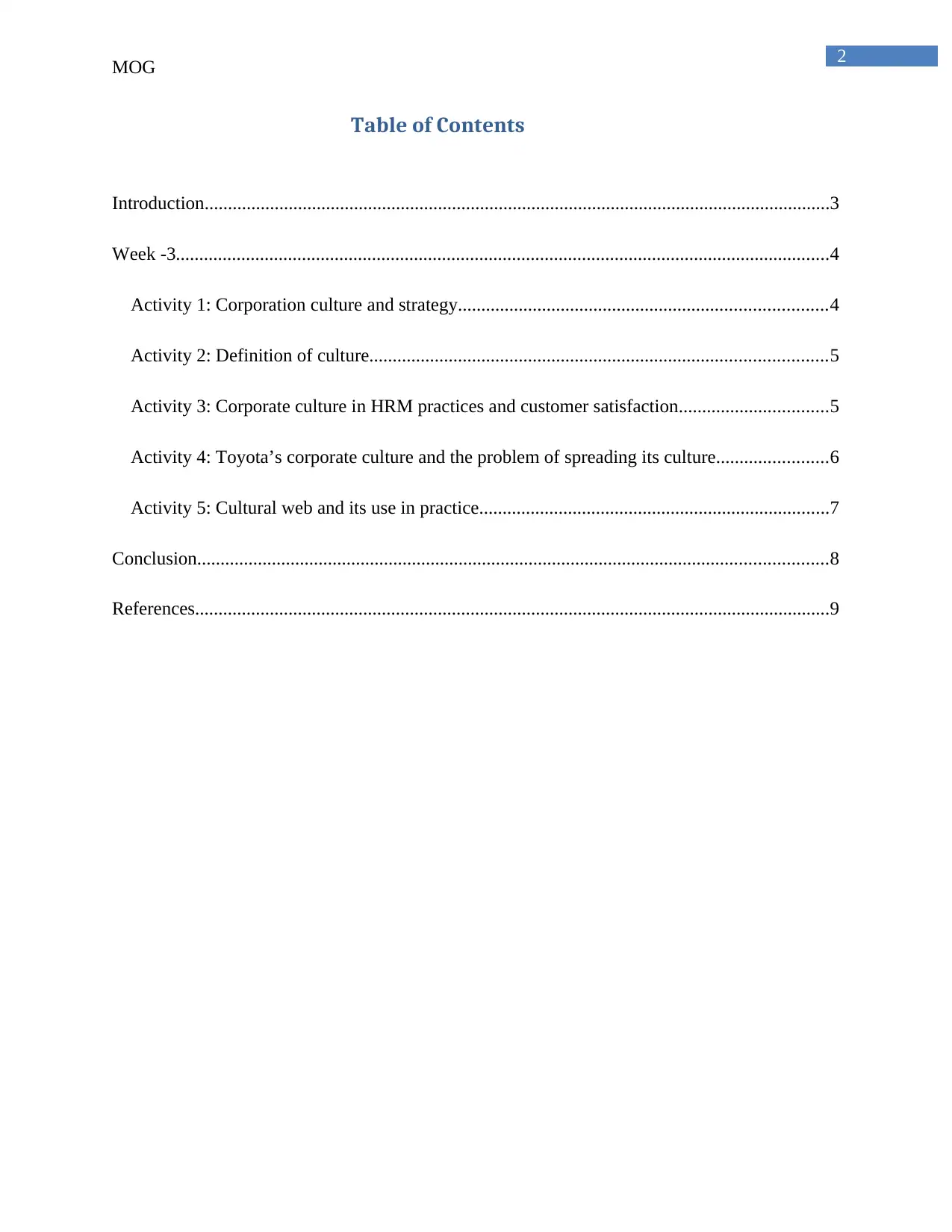
2
MOG
Table of Contents
Introduction......................................................................................................................................3
Week -3............................................................................................................................................4
Activity 1: Corporation culture and strategy...............................................................................4
Activity 2: Definition of culture..................................................................................................5
Activity 3: Corporate culture in HRM practices and customer satisfaction................................5
Activity 4: Toyota’s corporate culture and the problem of spreading its culture........................6
Activity 5: Cultural web and its use in practice...........................................................................7
Conclusion.......................................................................................................................................8
References........................................................................................................................................9
MOG
Table of Contents
Introduction......................................................................................................................................3
Week -3............................................................................................................................................4
Activity 1: Corporation culture and strategy...............................................................................4
Activity 2: Definition of culture..................................................................................................5
Activity 3: Corporate culture in HRM practices and customer satisfaction................................5
Activity 4: Toyota’s corporate culture and the problem of spreading its culture........................6
Activity 5: Cultural web and its use in practice...........................................................................7
Conclusion.......................................................................................................................................8
References........................................................................................................................................9
⊘ This is a preview!⊘
Do you want full access?
Subscribe today to unlock all pages.

Trusted by 1+ million students worldwide
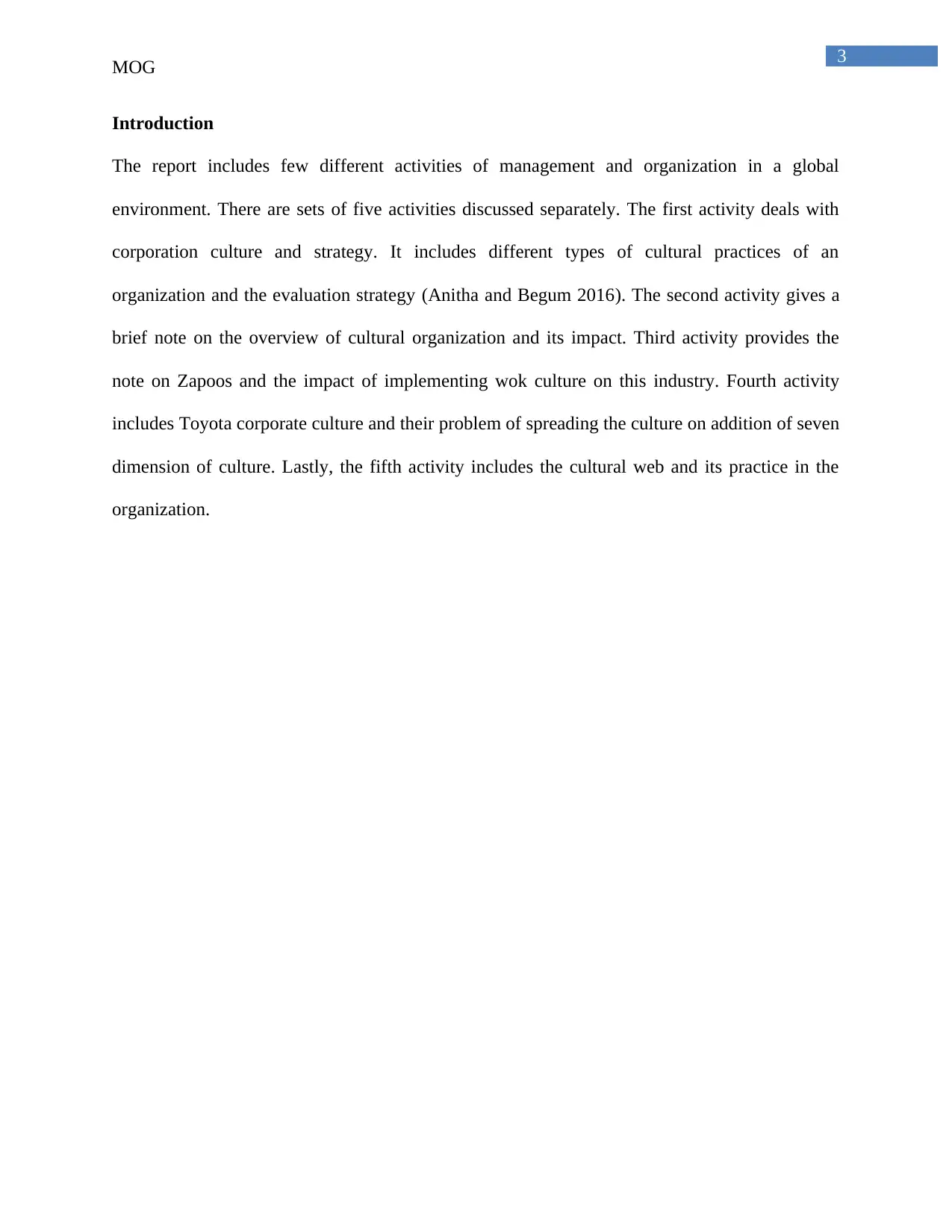
3
MOG
Introduction
The report includes few different activities of management and organization in a global
environment. There are sets of five activities discussed separately. The first activity deals with
corporation culture and strategy. It includes different types of cultural practices of an
organization and the evaluation strategy (Anitha and Begum 2016). The second activity gives a
brief note on the overview of cultural organization and its impact. Third activity provides the
note on Zapoos and the impact of implementing wok culture on this industry. Fourth activity
includes Toyota corporate culture and their problem of spreading the culture on addition of seven
dimension of culture. Lastly, the fifth activity includes the cultural web and its practice in the
organization.
MOG
Introduction
The report includes few different activities of management and organization in a global
environment. There are sets of five activities discussed separately. The first activity deals with
corporation culture and strategy. It includes different types of cultural practices of an
organization and the evaluation strategy (Anitha and Begum 2016). The second activity gives a
brief note on the overview of cultural organization and its impact. Third activity provides the
note on Zapoos and the impact of implementing wok culture on this industry. Fourth activity
includes Toyota corporate culture and their problem of spreading the culture on addition of seven
dimension of culture. Lastly, the fifth activity includes the cultural web and its practice in the
organization.
Paraphrase This Document
Need a fresh take? Get an instant paraphrase of this document with our AI Paraphraser
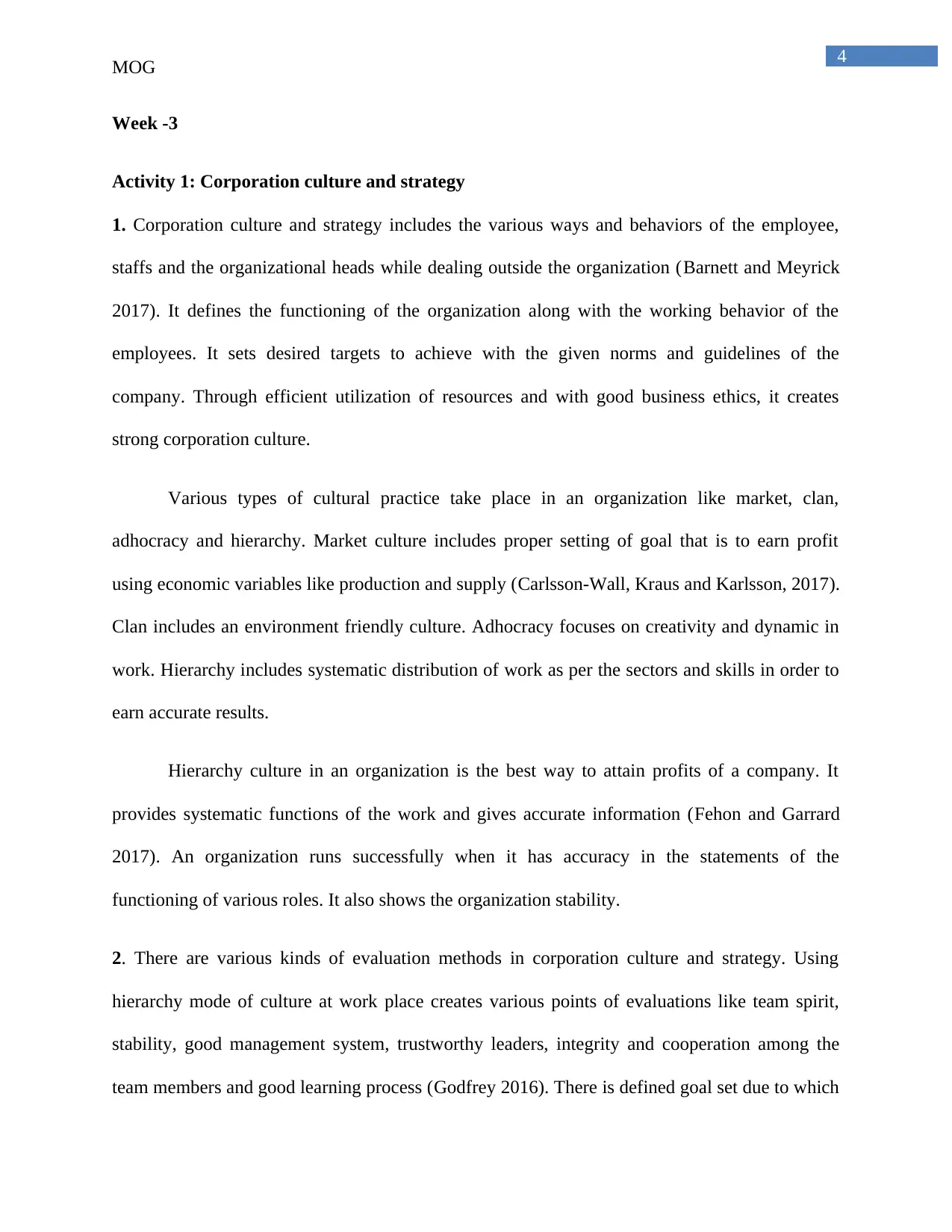
4
MOG
Week -3
Activity 1: Corporation culture and strategy
1. Corporation culture and strategy includes the various ways and behaviors of the employee,
staffs and the organizational heads while dealing outside the organization (Barnett and Meyrick
2017). It defines the functioning of the organization along with the working behavior of the
employees. It sets desired targets to achieve with the given norms and guidelines of the
company. Through efficient utilization of resources and with good business ethics, it creates
strong corporation culture.
Various types of cultural practice take place in an organization like market, clan,
adhocracy and hierarchy. Market culture includes proper setting of goal that is to earn profit
using economic variables like production and supply (Carlsson-Wall, Kraus and Karlsson, 2017).
Clan includes an environment friendly culture. Adhocracy focuses on creativity and dynamic in
work. Hierarchy includes systematic distribution of work as per the sectors and skills in order to
earn accurate results.
Hierarchy culture in an organization is the best way to attain profits of a company. It
provides systematic functions of the work and gives accurate information (Fehon and Garrard
2017). An organization runs successfully when it has accuracy in the statements of the
functioning of various roles. It also shows the organization stability.
2. There are various kinds of evaluation methods in corporation culture and strategy. Using
hierarchy mode of culture at work place creates various points of evaluations like team spirit,
stability, good management system, trustworthy leaders, integrity and cooperation among the
team members and good learning process (Godfrey 2016). There is defined goal set due to which
MOG
Week -3
Activity 1: Corporation culture and strategy
1. Corporation culture and strategy includes the various ways and behaviors of the employee,
staffs and the organizational heads while dealing outside the organization (Barnett and Meyrick
2017). It defines the functioning of the organization along with the working behavior of the
employees. It sets desired targets to achieve with the given norms and guidelines of the
company. Through efficient utilization of resources and with good business ethics, it creates
strong corporation culture.
Various types of cultural practice take place in an organization like market, clan,
adhocracy and hierarchy. Market culture includes proper setting of goal that is to earn profit
using economic variables like production and supply (Carlsson-Wall, Kraus and Karlsson, 2017).
Clan includes an environment friendly culture. Adhocracy focuses on creativity and dynamic in
work. Hierarchy includes systematic distribution of work as per the sectors and skills in order to
earn accurate results.
Hierarchy culture in an organization is the best way to attain profits of a company. It
provides systematic functions of the work and gives accurate information (Fehon and Garrard
2017). An organization runs successfully when it has accuracy in the statements of the
functioning of various roles. It also shows the organization stability.
2. There are various kinds of evaluation methods in corporation culture and strategy. Using
hierarchy mode of culture at work place creates various points of evaluations like team spirit,
stability, good management system, trustworthy leaders, integrity and cooperation among the
team members and good learning process (Godfrey 2016). There is defined goal set due to which
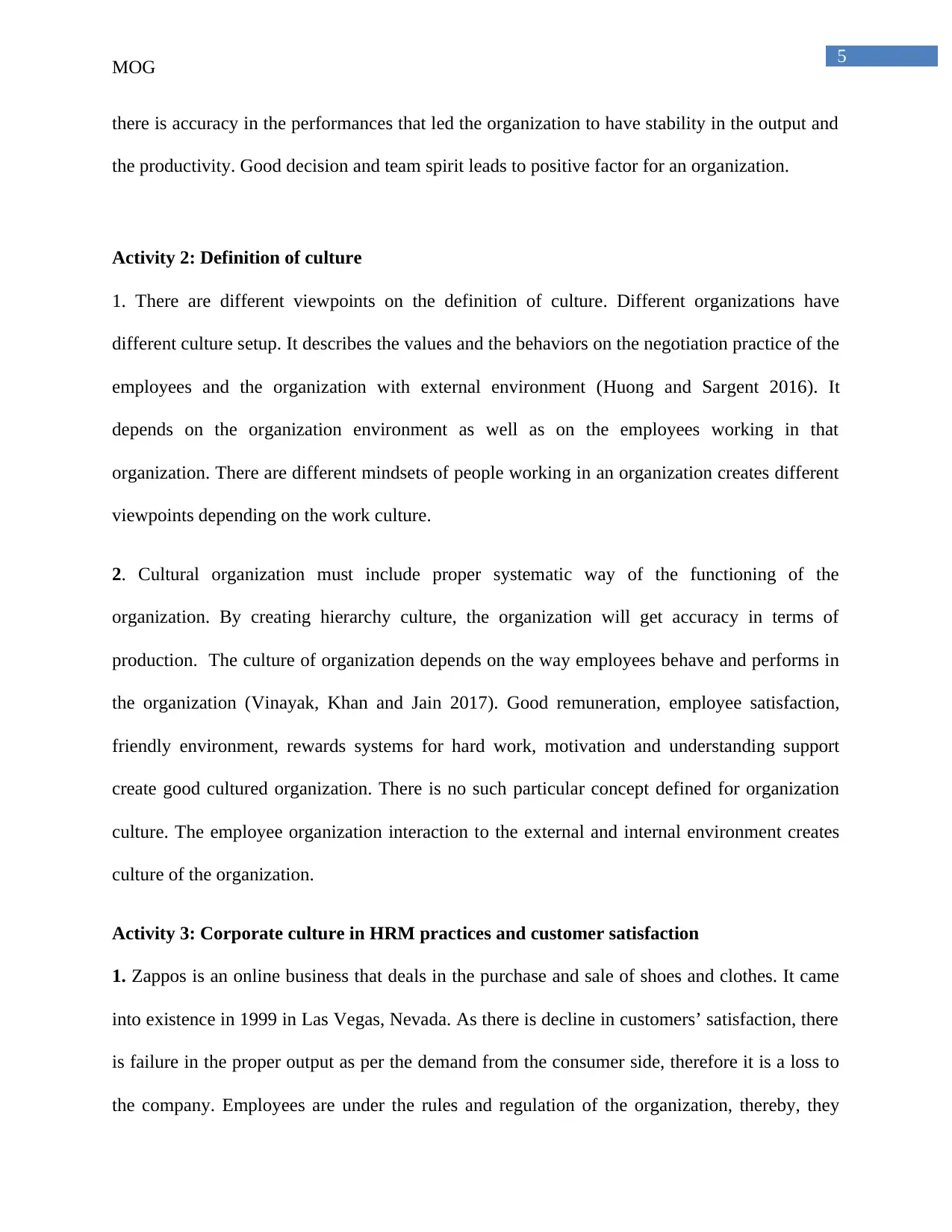
5
MOG
there is accuracy in the performances that led the organization to have stability in the output and
the productivity. Good decision and team spirit leads to positive factor for an organization.
Activity 2: Definition of culture
1. There are different viewpoints on the definition of culture. Different organizations have
different culture setup. It describes the values and the behaviors on the negotiation practice of the
employees and the organization with external environment (Huong and Sargent 2016). It
depends on the organization environment as well as on the employees working in that
organization. There are different mindsets of people working in an organization creates different
viewpoints depending on the work culture.
2. Cultural organization must include proper systematic way of the functioning of the
organization. By creating hierarchy culture, the organization will get accuracy in terms of
production. The culture of organization depends on the way employees behave and performs in
the organization (Vinayak, Khan and Jain 2017). Good remuneration, employee satisfaction,
friendly environment, rewards systems for hard work, motivation and understanding support
create good cultured organization. There is no such particular concept defined for organization
culture. The employee organization interaction to the external and internal environment creates
culture of the organization.
Activity 3: Corporate culture in HRM practices and customer satisfaction
1. Zappos is an online business that deals in the purchase and sale of shoes and clothes. It came
into existence in 1999 in Las Vegas, Nevada. As there is decline in customers’ satisfaction, there
is failure in the proper output as per the demand from the consumer side, therefore it is a loss to
the company. Employees are under the rules and regulation of the organization, thereby, they
MOG
there is accuracy in the performances that led the organization to have stability in the output and
the productivity. Good decision and team spirit leads to positive factor for an organization.
Activity 2: Definition of culture
1. There are different viewpoints on the definition of culture. Different organizations have
different culture setup. It describes the values and the behaviors on the negotiation practice of the
employees and the organization with external environment (Huong and Sargent 2016). It
depends on the organization environment as well as on the employees working in that
organization. There are different mindsets of people working in an organization creates different
viewpoints depending on the work culture.
2. Cultural organization must include proper systematic way of the functioning of the
organization. By creating hierarchy culture, the organization will get accuracy in terms of
production. The culture of organization depends on the way employees behave and performs in
the organization (Vinayak, Khan and Jain 2017). Good remuneration, employee satisfaction,
friendly environment, rewards systems for hard work, motivation and understanding support
create good cultured organization. There is no such particular concept defined for organization
culture. The employee organization interaction to the external and internal environment creates
culture of the organization.
Activity 3: Corporate culture in HRM practices and customer satisfaction
1. Zappos is an online business that deals in the purchase and sale of shoes and clothes. It came
into existence in 1999 in Las Vegas, Nevada. As there is decline in customers’ satisfaction, there
is failure in the proper output as per the demand from the consumer side, therefore it is a loss to
the company. Employees are under the rules and regulation of the organization, thereby, they
⊘ This is a preview!⊘
Do you want full access?
Subscribe today to unlock all pages.

Trusted by 1+ million students worldwide
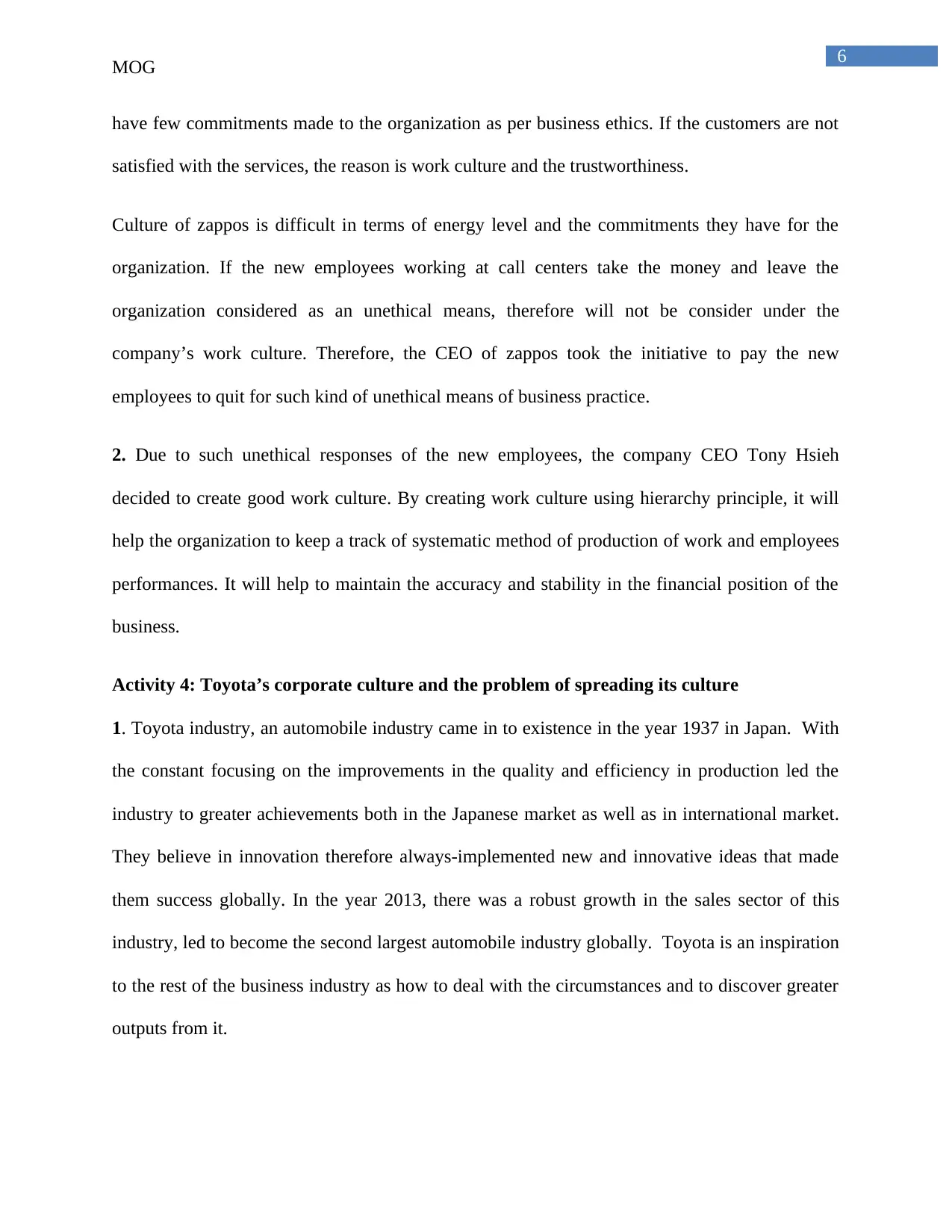
6
MOG
have few commitments made to the organization as per business ethics. If the customers are not
satisfied with the services, the reason is work culture and the trustworthiness.
Culture of zappos is difficult in terms of energy level and the commitments they have for the
organization. If the new employees working at call centers take the money and leave the
organization considered as an unethical means, therefore will not be consider under the
company’s work culture. Therefore, the CEO of zappos took the initiative to pay the new
employees to quit for such kind of unethical means of business practice.
2. Due to such unethical responses of the new employees, the company CEO Tony Hsieh
decided to create good work culture. By creating work culture using hierarchy principle, it will
help the organization to keep a track of systematic method of production of work and employees
performances. It will help to maintain the accuracy and stability in the financial position of the
business.
Activity 4: Toyota’s corporate culture and the problem of spreading its culture
1. Toyota industry, an automobile industry came in to existence in the year 1937 in Japan. With
the constant focusing on the improvements in the quality and efficiency in production led the
industry to greater achievements both in the Japanese market as well as in international market.
They believe in innovation therefore always-implemented new and innovative ideas that made
them success globally. In the year 2013, there was a robust growth in the sales sector of this
industry, led to become the second largest automobile industry globally. Toyota is an inspiration
to the rest of the business industry as how to deal with the circumstances and to discover greater
outputs from it.
MOG
have few commitments made to the organization as per business ethics. If the customers are not
satisfied with the services, the reason is work culture and the trustworthiness.
Culture of zappos is difficult in terms of energy level and the commitments they have for the
organization. If the new employees working at call centers take the money and leave the
organization considered as an unethical means, therefore will not be consider under the
company’s work culture. Therefore, the CEO of zappos took the initiative to pay the new
employees to quit for such kind of unethical means of business practice.
2. Due to such unethical responses of the new employees, the company CEO Tony Hsieh
decided to create good work culture. By creating work culture using hierarchy principle, it will
help the organization to keep a track of systematic method of production of work and employees
performances. It will help to maintain the accuracy and stability in the financial position of the
business.
Activity 4: Toyota’s corporate culture and the problem of spreading its culture
1. Toyota industry, an automobile industry came in to existence in the year 1937 in Japan. With
the constant focusing on the improvements in the quality and efficiency in production led the
industry to greater achievements both in the Japanese market as well as in international market.
They believe in innovation therefore always-implemented new and innovative ideas that made
them success globally. In the year 2013, there was a robust growth in the sales sector of this
industry, led to become the second largest automobile industry globally. Toyota is an inspiration
to the rest of the business industry as how to deal with the circumstances and to discover greater
outputs from it.
Paraphrase This Document
Need a fresh take? Get an instant paraphrase of this document with our AI Paraphraser
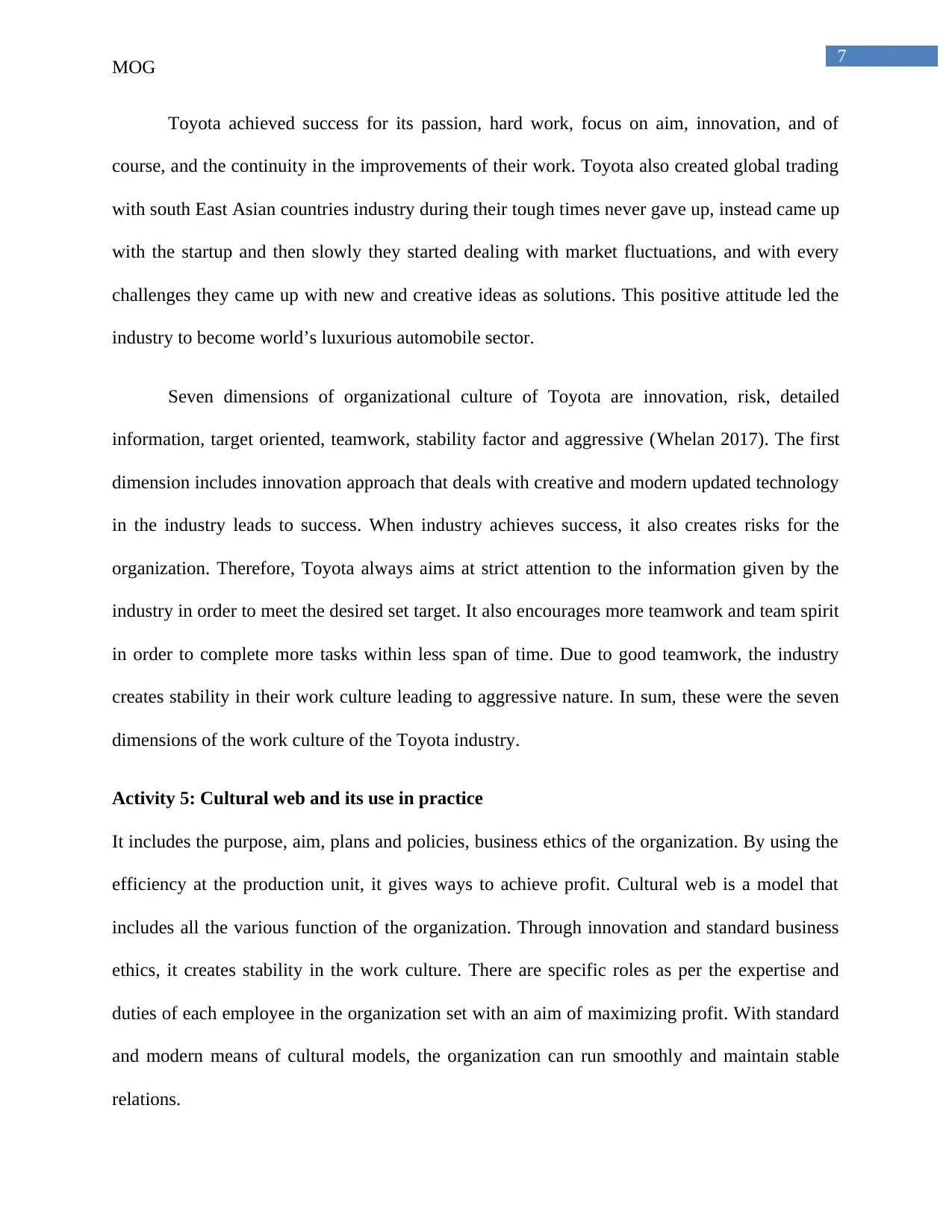
7
MOG
Toyota achieved success for its passion, hard work, focus on aim, innovation, and of
course, and the continuity in the improvements of their work. Toyota also created global trading
with south East Asian countries industry during their tough times never gave up, instead came up
with the startup and then slowly they started dealing with market fluctuations, and with every
challenges they came up with new and creative ideas as solutions. This positive attitude led the
industry to become world’s luxurious automobile sector.
Seven dimensions of organizational culture of Toyota are innovation, risk, detailed
information, target oriented, teamwork, stability factor and aggressive (Whelan 2017). The first
dimension includes innovation approach that deals with creative and modern updated technology
in the industry leads to success. When industry achieves success, it also creates risks for the
organization. Therefore, Toyota always aims at strict attention to the information given by the
industry in order to meet the desired set target. It also encourages more teamwork and team spirit
in order to complete more tasks within less span of time. Due to good teamwork, the industry
creates stability in their work culture leading to aggressive nature. In sum, these were the seven
dimensions of the work culture of the Toyota industry.
Activity 5: Cultural web and its use in practice
It includes the purpose, aim, plans and policies, business ethics of the organization. By using the
efficiency at the production unit, it gives ways to achieve profit. Cultural web is a model that
includes all the various function of the organization. Through innovation and standard business
ethics, it creates stability in the work culture. There are specific roles as per the expertise and
duties of each employee in the organization set with an aim of maximizing profit. With standard
and modern means of cultural models, the organization can run smoothly and maintain stable
relations.
MOG
Toyota achieved success for its passion, hard work, focus on aim, innovation, and of
course, and the continuity in the improvements of their work. Toyota also created global trading
with south East Asian countries industry during their tough times never gave up, instead came up
with the startup and then slowly they started dealing with market fluctuations, and with every
challenges they came up with new and creative ideas as solutions. This positive attitude led the
industry to become world’s luxurious automobile sector.
Seven dimensions of organizational culture of Toyota are innovation, risk, detailed
information, target oriented, teamwork, stability factor and aggressive (Whelan 2017). The first
dimension includes innovation approach that deals with creative and modern updated technology
in the industry leads to success. When industry achieves success, it also creates risks for the
organization. Therefore, Toyota always aims at strict attention to the information given by the
industry in order to meet the desired set target. It also encourages more teamwork and team spirit
in order to complete more tasks within less span of time. Due to good teamwork, the industry
creates stability in their work culture leading to aggressive nature. In sum, these were the seven
dimensions of the work culture of the Toyota industry.
Activity 5: Cultural web and its use in practice
It includes the purpose, aim, plans and policies, business ethics of the organization. By using the
efficiency at the production unit, it gives ways to achieve profit. Cultural web is a model that
includes all the various function of the organization. Through innovation and standard business
ethics, it creates stability in the work culture. There are specific roles as per the expertise and
duties of each employee in the organization set with an aim of maximizing profit. With standard
and modern means of cultural models, the organization can run smoothly and maintain stable
relations.
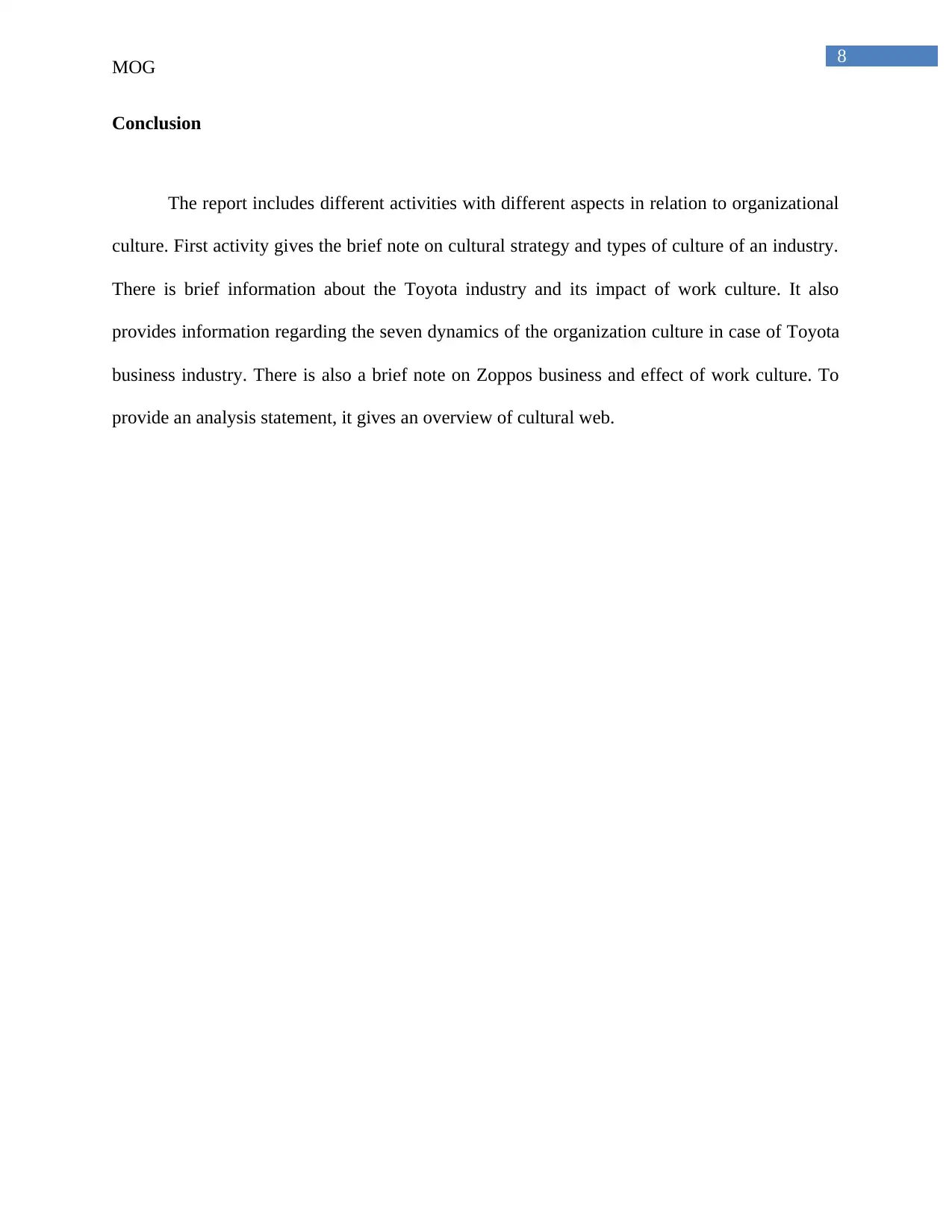
8
MOG
Conclusion
The report includes different activities with different aspects in relation to organizational
culture. First activity gives the brief note on cultural strategy and types of culture of an industry.
There is brief information about the Toyota industry and its impact of work culture. It also
provides information regarding the seven dynamics of the organization culture in case of Toyota
business industry. There is also a brief note on Zoppos business and effect of work culture. To
provide an analysis statement, it gives an overview of cultural web.
MOG
Conclusion
The report includes different activities with different aspects in relation to organizational
culture. First activity gives the brief note on cultural strategy and types of culture of an industry.
There is brief information about the Toyota industry and its impact of work culture. It also
provides information regarding the seven dynamics of the organization culture in case of Toyota
business industry. There is also a brief note on Zoppos business and effect of work culture. To
provide an analysis statement, it gives an overview of cultural web.
⊘ This is a preview!⊘
Do you want full access?
Subscribe today to unlock all pages.

Trusted by 1+ million students worldwide
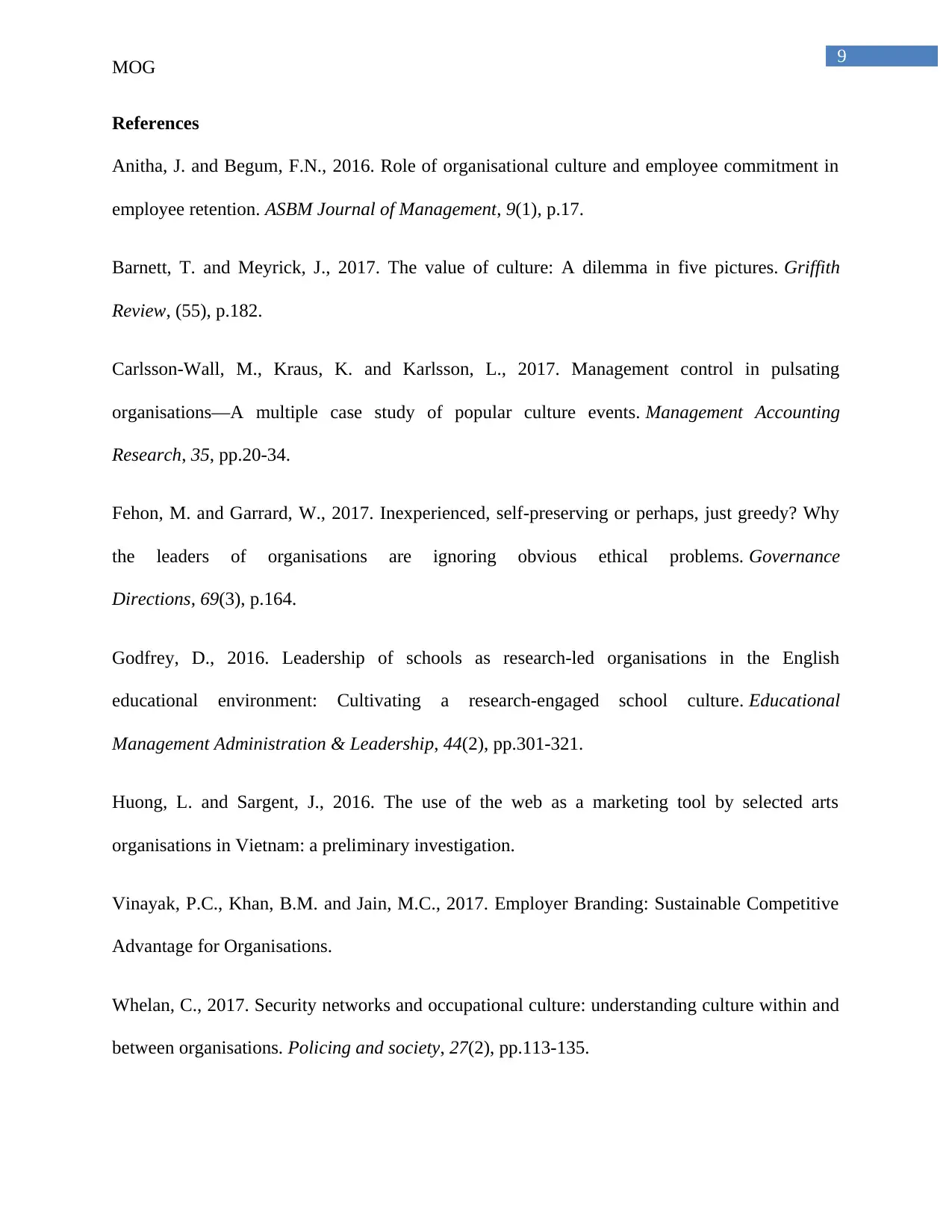
9
MOG
References
Anitha, J. and Begum, F.N., 2016. Role of organisational culture and employee commitment in
employee retention. ASBM Journal of Management, 9(1), p.17.
Barnett, T. and Meyrick, J., 2017. The value of culture: A dilemma in five pictures. Griffith
Review, (55), p.182.
Carlsson-Wall, M., Kraus, K. and Karlsson, L., 2017. Management control in pulsating
organisations—A multiple case study of popular culture events. Management Accounting
Research, 35, pp.20-34.
Fehon, M. and Garrard, W., 2017. Inexperienced, self-preserving or perhaps, just greedy? Why
the leaders of organisations are ignoring obvious ethical problems. Governance
Directions, 69(3), p.164.
Godfrey, D., 2016. Leadership of schools as research-led organisations in the English
educational environment: Cultivating a research-engaged school culture. Educational
Management Administration & Leadership, 44(2), pp.301-321.
Huong, L. and Sargent, J., 2016. The use of the web as a marketing tool by selected arts
organisations in Vietnam: a preliminary investigation.
Vinayak, P.C., Khan, B.M. and Jain, M.C., 2017. Employer Branding: Sustainable Competitive
Advantage for Organisations.
Whelan, C., 2017. Security networks and occupational culture: understanding culture within and
between organisations. Policing and society, 27(2), pp.113-135.
MOG
References
Anitha, J. and Begum, F.N., 2016. Role of organisational culture and employee commitment in
employee retention. ASBM Journal of Management, 9(1), p.17.
Barnett, T. and Meyrick, J., 2017. The value of culture: A dilemma in five pictures. Griffith
Review, (55), p.182.
Carlsson-Wall, M., Kraus, K. and Karlsson, L., 2017. Management control in pulsating
organisations—A multiple case study of popular culture events. Management Accounting
Research, 35, pp.20-34.
Fehon, M. and Garrard, W., 2017. Inexperienced, self-preserving or perhaps, just greedy? Why
the leaders of organisations are ignoring obvious ethical problems. Governance
Directions, 69(3), p.164.
Godfrey, D., 2016. Leadership of schools as research-led organisations in the English
educational environment: Cultivating a research-engaged school culture. Educational
Management Administration & Leadership, 44(2), pp.301-321.
Huong, L. and Sargent, J., 2016. The use of the web as a marketing tool by selected arts
organisations in Vietnam: a preliminary investigation.
Vinayak, P.C., Khan, B.M. and Jain, M.C., 2017. Employer Branding: Sustainable Competitive
Advantage for Organisations.
Whelan, C., 2017. Security networks and occupational culture: understanding culture within and
between organisations. Policing and society, 27(2), pp.113-135.
Paraphrase This Document
Need a fresh take? Get an instant paraphrase of this document with our AI Paraphraser

10
MOG
MOG
1 out of 11
Related Documents
Your All-in-One AI-Powered Toolkit for Academic Success.
+13062052269
info@desklib.com
Available 24*7 on WhatsApp / Email
![[object Object]](/_next/static/media/star-bottom.7253800d.svg)
Unlock your academic potential
Copyright © 2020–2025 A2Z Services. All Rights Reserved. Developed and managed by ZUCOL.





